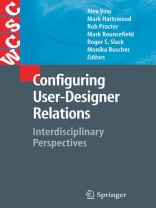‘User-designer relations’ concerns the sorts of working relationships that arise between developers and end users of IT products – the different ways designers of IT products seek to engage with users, and the ways users seek to influence product design. It is through the shifting patterns of these relations that IT products are realised. Although it has generally been accepted that achieving better user-designer relations will improve the quality of IT products, there has been little consensus on how this might be achieved.
This book aims to deepen our understanding of the relationships between users and designers both as they emerge in the wild and as a consequence of our attempts to intervene. Through a series of case studies the book juxtaposes in-depth explorations of different perspectives and approaches to thinking about – and doing – user-designer relations, considering important implications for design and computer science more generally.
Table of Content
Introduction: Configuring User-Designer Relations: Interdisciplinary Perspectives.- Participatory Design: Issues and Approaches in Dynamic Constellations of Use, Design, and Research.- Design as and for Collaboration: Making Sense of and Supporting Practical Action.- User-Designer Relations in Technology Production: The Development and Evaluation of an ‘Animator’ Tool to Facilitate User Involvement in the Development of Electronic Health Records.- Lessons Learnt in Providing Product Designers with User-Participatory Interaction Design Tools.- A Break from Novelty: Persistence and Effects of Structural Tensions in User–Designer Relations.- Practicalities of Participation: Stakeholder Involvement in an Electronic Patient Records Project.- Bottom-up, Top-down? Connecting Software Architecture Design with Use.- Global Software and its Provenance: Generification Work in the Production of Organisational Software Packages.- Concluding Remarks.












